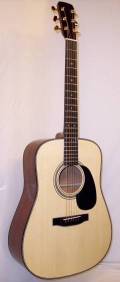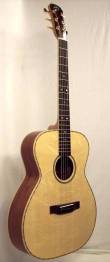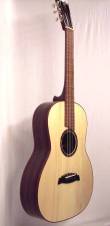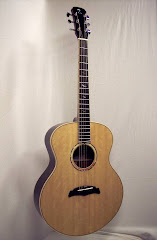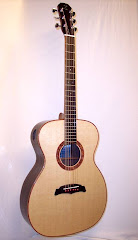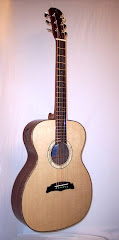Once I finished my 'happy dance' I had to figure where I left off last week. I was very anxious to cut the fingerboard fret slots so I started with that. I spent quite a bit of time marking the board using the table on the plans. It was at this point that I remembered that I had the program Wfret on my computer for making these calculations. The nice thing about the program is that it also will print out the fret positions exactly to within 1/100 inch. I ran back to my house, fired up the program and printed out the template. The good news is that the template matched what I had oh so carefully marked out on the wood. Unfortunately, I spent a good hour measuring and marking and that time was wasted. Oh well, at least I know how to measure and I was marking within 1/1000", of course no matter how sharp the pencil, the line is still wide. Anyways, I took the template, taped it to the fingerboard material and used the jig I made last week to cut the slots. It went quite well using the fret blade from Stewmac on my table saw. The blade does a nice job cutting, but I was a bit concerned that the blade is just high speed steel and it seems like it will dull pretty quickly. Maybe I am wrong but I guess I was expecting something a bit more substantial. The blade did smoke a little cutting the Granadillo fingerboard material but the cuts were clean and effortless.
After that, I cut some of the material off of the neck heal but didn't do any shaping yet. I then cut out the peghead shape. I wanted to use the same peghead shape as I have used on my other guitars, but with this being a slotted head neck, I can't use the curves on the sides. So I made a new template with the same curved top, and notches, but with straight edges for the tuners. Once that was all cut and flush routed I decided to drill the tuner holes. I was thinking that it was probably smart to drill these holes first before cutting the slots that way there is no chance of blowout inside the slots. I used the jig after some modifications to hand drill the holes. I drilled them using the dimensions of Grover tuners so I guess that is what I am stuck using! (As if Waverly tuners were ever an option! lol )
I also spent a few minutes hanging a track light over my work table with three wide adjustable color corrected fluorescent lights. My shop has decent lighting, but doing these guitars made me realize that a lot of good light is essential for the detail work, as well as finishing. I have been using clamp on flood lights to get additional light where needed, but this is a lot nicer.
Tomorrow I will spend some more time working the neck, probably cutting the peghead slots. The humidity has been in the 40's too so I might work on bracing while the weather permits.

This is how I lined everything up. I ran the saw blade through the fence giving me the exact location of the cut above the board. Then I just lined my marks up and slid it through the blade.

The fingerboard all cut. Call my crazy but it was really exciting taking the board off the jig and looking at the finished product. It is really cool taking my digital calipers and finding my cuts all match the plan!

The peghead cut to shape. Note that I had to use straight sides instead of the curved sides I normally use. I am thinking about how to make a 'fancy' slot. I still haven't worked that out yet.

Here are the modifications to the jig. I had to angle the ends so it fit inside the peghead angle, and I had to shave the edges where it comes to the peghead angle.

The peghead after the holes were drilled. The holes are dead center between the face and back of the peghead. It looks off center because of the peghead veneer. The holes are not center of the cedar, but of the overall peghead thickness.
 Last but not least, here are the lights I put over the workbench. I was able to salvage these plus 7 more from the job I was working this week. I removed them from a showroom and they were going in the trash. I figured they would be perfect for my shop.
Last but not least, here are the lights I put over the workbench. I was able to salvage these plus 7 more from the job I was working this week. I removed them from a showroom and they were going in the trash. I figured they would be perfect for my shop.















































